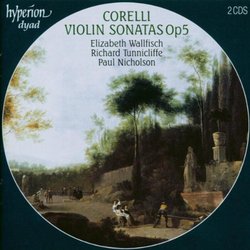| All Artists: Arcangelo Corelli, Francesco Geminiani, Convivium Musicum Title: Corelli: Violin Sonatas, Op. 5 Members Wishing: 0 Total Copies: 0 Label: Hyperion UK Original Release Date: 1/1/2000 Re-Release Date: 1/13/2004 Album Type: Import Genre: Classical Styles: Chamber Music, Forms & Genres, Concertos, Historical Periods, Baroque (c.1600-1750), Classical (c.1770-1830), Instruments, Strings Number of Discs: 2 SwapaCD Credits: 2 UPC: 034571120478 |
Search - Arcangelo Corelli, Francesco Geminiani, Convivium Musicum :: Corelli: Violin Sonatas, Op. 5
 | Arcangelo Corelli, Francesco Geminiani, Convivium Musicum Corelli: Violin Sonatas, Op. 5 Genre: Classical |
Larger Image |
CD Details |
CD ReviewsTranscendent Italian baroque Daniel R. Greenfield | Milwaukee, Wisconsin, United States | 06/12/2006 (5 out of 5 stars) "Having already spent many enjoyable hours listening to baroque violinist Andrew Manze and harpsichordist Richard Egarr perform these sonatas on their recent Harmonia Mundi recording, I was drawn to purchase this slightly older recording on Hyperion, now that it has been repackaged as a discounted 'Dyad'. I wanted to have at least two versions in order to be able to hear these much-beloved sonatas performed in different ways. Accordingly, this review will be in large part a contrast between the Manze-Egarr recording on HM and this one by Wallfisch and her Convivium ensemble on Hyperion.
You don't need to be a rocket scientist to realize that Manze has a more emphatic style than Wallfisch. Wallfisch is understated, exceedingly subtle, and at times you must turn the volume up in order to hear her clearly. With Manze, it's just the opposite; in fact he can induce mild ear-pain at times. Manze overall is more forthright; amazingly prolific, oratorical, delivering flawless interpretations with ease and the greatest dexterity. What is missing from Manze is a wider dynamic range; it seems as if everything is played forte. Wallfisch plays with more staccatto strokes, and with a much more subdued tone than Manze. The end result is that, depending on the movement, Manze's rendering will sometimes seem the better, and sometimes Wallfisch's. On this recording, the opening movement of the first sonata is simply breathtaking: Wallfisch's violin, with the greatest subtletly and consummate finesse, soars with ingenious ornamentation and a perfectly understated lyricism. And overall I would say that Wallfisch is decidedly better at the ornamentation than Manze. The last sonata, La Follia, which Wallfisch plays superbly, carefully nuancing each stroke of the variations, clearly showcases Wallfisch's careful, deliberate yet understated bowing technique. But elsewhere, it is Manze's style of playing that I prefer. To my ear, Wallfisch mangles the beautiful opening movement of sonata VII, while Manze has captured its sweet lyricism perfectly. These are two very different artists, and both prodigiously gifted, each with a unique tone and style. Wallfisch is nuanced, careful, considerate, understated, and precise. She has less emphatic polish, and while this creates a sense of diminished presence on first encounter, her sound and style wear much better on the ear with repeated listening. In summary, both recordings put forth their own unique light. While Manze's recording has brought a sense of freshness to these time-worn pieces, Wallfisch's great sense of nuance, greater subtletly of ornamentation, and overall gentler tone, bring me back repeatedly to her recording." |
